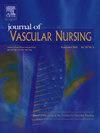外周动脉疾病患者呼吸功能、功能性运动能力与踝肱指数的关系
IF 1.2
Q3 NURSING
引用次数: 0
摘要
目的外周动脉病变(PAD)是动脉粥样硬化的常见临床表现。本研究旨在探讨PAD患者呼吸功能和功能性运动能力与踝肱指数(踝肱指数,ABI)的关系。方法采用横断面设计。通过呼吸功能测试,使用肺活量计测量呼吸功能。测量以下值:1秒内用力呼气量(FEV1)、用力肺活量(FVC)、FEV1/FVC比值、25%用力肺活量流量(FEF25)、75%用力肺活量流量(FEF75)、25% ~ 75%用力肺活量平均流量(FEF25 - 75)。采用6分钟步行测试(6MWT)评估功能性运动能力,并测量ABI。结果纳入PAD患者95例,平均年龄52.0±8.3岁。平均ABI值为0.86±0.17。参与者在6小时内平均步行374.59±82.16米。ABI与FEV1、FVC、PEF、6 MWT呈正相关(rs:0.56, p < 0.001; rs:0.39, p < 0.001; rs:0.34, p < 0.001; rs:0.64, p < 0.001)。其他呼吸功能指标也与ABI呈显著正相关(p < 0.05)。结论本研究表明ABI值的升高与PAD患者呼吸功能和功能性运动能力的改善有关。PAD患者的呼吸参数评估和旨在改善呼吸功能的康复方法的实施可能对疾病的管理有积极的贡献。踝肱指数,功能容量,外周动脉疾病,呼吸功能测试。本文章由计算机程序翻译,如有差异,请以英文原文为准。
The relationship between respiratory function, functional exercise capacity, and the ankle-brachial index in patients with peripheral arterial disease
Purpose
Peripheral arterial disease (PAD) is a common clinical manifestations of atherosclerosis. The aim of this study is to investigate the relation of respiratory function and functional exercise capacity with the ankle-brachial index (ABI) in patients with PAD.
Method
The study adopted a cross-sectional design. The respiratory function was measured using a spirometer through respiratory function tests. The following values measured: Forced Expiratory Volume in 1 s (FEV1), Forced Vital Capacity (FVC), FEV1/FVC ratio, 25 % Flow of Forced Vital Capacity (FEF25), 75 % Flow of Forced Vital Capacity (FEF75), and the average flow between 25 % and 75 % of Forced Vital Capacity (FEF25–75). Functional exercise capacity was assessed using the 6-Minute Walk Test (6MWT) and ABI was measured.
Results
The study included 95 patients with PAD (mean age: 52.0 ± 8.3 years). The mean ABI value was 0.86 ± 0.17. The participants walked an average of 374.59 ± 82.16 m in the 6MWT. There were positive correlation between ABI and FEV1, FVC, PEF, 6 MWT (rs:0.56, p < 0.001; rs:0.39, p < 0.001; rs:0.34, p:0.001; rs:0.64, p < 0.001, respectively). The other respiratory function outcomes also demonstrated significant positive relations with ABI (p < 0.05).
Conclusion
This study demonstrated that increases in ABI values were associated with improvements in respiratory function and functional exercise capacity in patients with PAD. Evaluation of respiratory parameters in patients with PAD and the implementation of rehabilitation approaches aimed at improving respiratory function may positively contribute to the management of the disease.
Anahtar Kelimeler
Ankle brachial index, functional capacity, peripheral arterial disease, respiratory function test.
求助全文
通过发布文献求助,成功后即可免费获取论文全文。
去求助
来源期刊

Journal of Vascular Nursing
NURSING-
CiteScore
1.40
自引率
0.00%
发文量
33
期刊介绍:
Journal of Vascular Nursing provides clinical information regarding aortic and peripheral aneurysms, upper and lower extremity arterial disease, acute and chronic venous disease, and more. Original, peer-reviewed articles present descriptions, etiologies, diagnostic procedures, medical and surgical treatment and nursing implications of vascular system disorders.
 求助内容:
求助内容: 应助结果提醒方式:
应助结果提醒方式:


